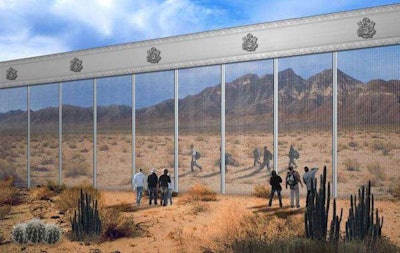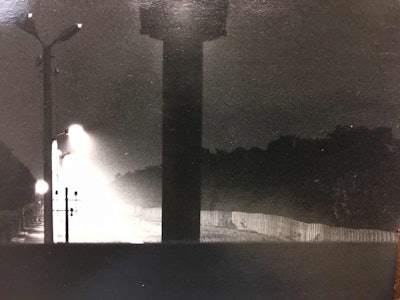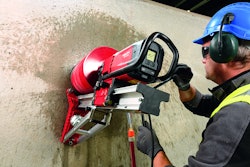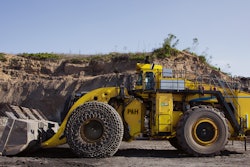 A rendering of the border wall proposal submitted by Fort Worth-based government/federal contractor Penna Group. The wall would have a two-way glass mirror effect, allowing U.S. officials see across the border, but not allowing those on the Mexico side to do the same. Photo credit: Penna Group
A rendering of the border wall proposal submitted by Fort Worth-based government/federal contractor Penna Group. The wall would have a two-way glass mirror effect, allowing U.S. officials see across the border, but not allowing those on the Mexico side to do the same. Photo credit: Penna GroupAs of last week, more than 700 companies had responded to the Customs and Border Patrol agency’s request for proposals on building President Trump’s wall between Mexico and the United States.
Early cost estimates for the 1,300 mile long wall run around $38 billion—the single most expensive infrastructure project ever undertaken in the U.S. The CBP says it will announce finalists in June.
The media has published some of the details in the agency’s request for proposals. I thought it would be instructive to highlight a few of these to point out just how unrealistic the project is.
The wall must be at least 18 feet tall, but the CBP would prefer 30 feet.
Well, which is it? Nothing like a tightly written spec to give you confidence the project owners know what they’re doing.
The wall must run to a depth of at least six feet.
Six feet? Has anybody at the CBP ever seen the movie the Great Escape, a real-life tale of a handful of WWII aviators who hand-dug a tunnel 30 feet down and 100 yards under the barbed wire fence of their POW compound? Or say those trying to enter the country illegally decide to bring some heavy equipment to the task. A medium-size horizontal directional drill can bore deeper and further than this in a matter of hours.
The barrier must stymie climbers armed with ladders, grappling hooks or handholds that can be affixed to the surface.
Mountain climbers use lightweight aluminum ladders to traverse hundreds of feet across the Khumbu Ice Fall at the base of Mt. Everest. They use bolts, ascenders, cam devices and other hardware to climb 3,000 feet straight up the Nose Route on El Capitan in Yosemite National Park. You think you can build a barrier harder to scale than Everest or El Capitan?
One company proposed using electronic surveillance technology. But all electronics can be hacked—as we saw this weekend when hackers set off all the weather warning sirens in Dallas, Texas.
Another company proposed lining the wall with solar panels, claiming the electricity they generate could help pay for the wall. Great idea if you had somebody to sell the electricity to. Trouble is, the area where they want to build the wall has few people, homes, or factories; maybe a ranch or two every thousand acres. It’s the most sparsely populated area in the country save for the Mojave Desert.
But my all-time favorite proposal isn’t a wall. According to National Public Radio, a group called the “Otra Nation” wants:
“A regenerative co-nation shared by citizens of both Mexico and the United States and co-maintained by respective governments…with the rights to cross open borders of the three North American countries without impediment…Rather than impede movement between nations, it’s hyper loop transit system would accelerate travel, effectively rendering the border moot.”
Be still my bleeding heart.
This is not to slight the difficult problems both countries face with uncontrolled immigration. Illegal immigrants drive down wages and increase social services costs here. And Mexico has a huge corruption problem with narco-gangsters having killed upwards of 100,000 people in the last decade alone. But what’s driving these immigrants north is our addiction to illegal drugs and low-wage workers. If nobody hired them, if nobody bought their illegal drugs, they wouldn’t be here.
We could solve the problem without a wall, if we had the integrity and backbone to enforce our laws. And a legal and administrative solution certainly wouldn’t cost $38 billion. We could increase the number of legal immigrants we let into this country, as long as they agree to work, pay taxes and not sponge off our welfare system. And we’d have to create a pathway to citizenship for those illegals who are already here. But we’re not going to deport 12-million people no matter how busy we get—that’s 500,000 people every month for two years. Won’t happen.
 The Berlin Wall, with its kill-zones, guard towers and search lights, came to symbolize the failure of communism. Will Trump’s wall become a symbol of our failure to enforce our own laws?
The Berlin Wall, with its kill-zones, guard towers and search lights, came to symbolize the failure of communism. Will Trump’s wall become a symbol of our failure to enforce our own laws?For some, it may be emotionally gratifying to think about building a wall that would make America great again, or something like that. But it won’t. Nobody in their right mind thinks we can build an impenetrable wall, 1,300 miles long. Even if we could, illegal immigrants would just come over in boats. That’s how millions of Muslim refugees got to Europe.
East Germany put up the Berlin Wall in 1961: a double wall with two parallel sections, completely encircling West Berlin. It had tank traps, barbed wire, land mines, machine gun towers and search lights closely spaced between the two walls. But the Berlin Wall was only 110 miles long, not 1,300. And even though the communists killed 138 wall jumpers in the next 38 years, thousands successfully got across. Despite the risks, East Germans never stopped trying to escape. The Berlin Wall came down in 1989 when the hypocrisy of communist ideology and economics proved unsustainable.
Washington D.C. can’t make the sensible choice when there is money on the table. But for those of you in the private sector who are eager to get a piece of this wall building deal, think about the implications. What does it say about your character if you are willing to take vast amounts of taxpayer money to build something bound to fail; a wall predicated on America’s addiction to illegal drugs and cheap labor and our hypocritical inability to enforce our own laws?
And 10 or 20 years from now, are you going to take your grandkids out in the desert to see this half-built, broken down and abandoned wall and proudly say: “See kids, I helped build that.”











